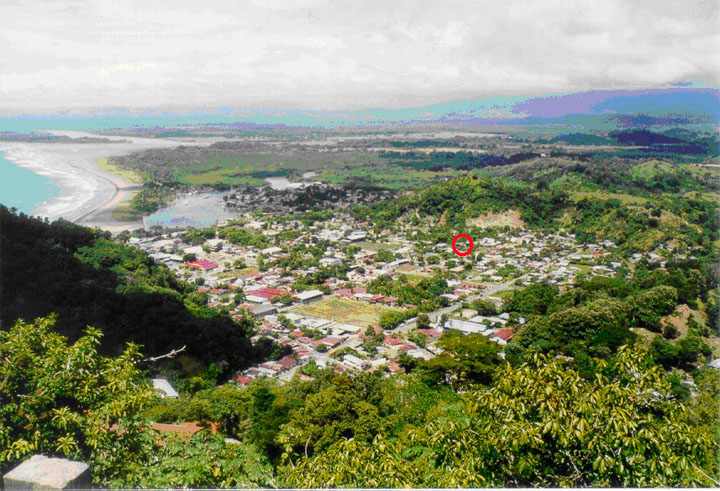|
|---|
The Peaceful Village of Quepos, Canton of Aguirre, Puntarenas Province, Costa Rica as Seen from |
Broken News
(All the News That's Fit to Reprint)
Costa Rica #1 in Futbol
Andy Warhol said everyone gets 15 minutes of fame.
To prove that point, Costa Rica's national futbol team recently found themselves leading the CONCACAF division (Confederation of North, Central American and Caribbean Associations of Futbol) of the FIFA world futbol.federation (for those in Rio Linda, futbol = soccer). The Ticos even eked out a pair of 0-0 ties with Mexico, even though the Mexicanos are often considered to be a much stronger team. That gave each team one point for each draw. But the leadership position can often change quickly and the U.S. has been right on both teams heels, racking up a couple of wins recently (2 points for each win). As a result, the U.S. then went ahead of the Ticos. The U.S. wins included the infamous game in the snow in Denver this past spring when the U.S. defeated Costa Rica 2-1 in a game most still think should not have been played,
The top three teams (currently the U.S., Costa Rica and Mexico) will be going to the World Cup competition in Brazil in 2014.
The Chronicles has been following the story of Nicaragua's planned construction of a canal across the Rio San Juan, a river that also serves as a border between Nicaragua and Costa Rica.
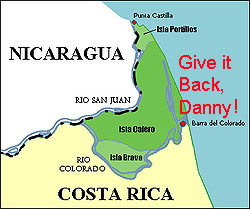 |
|---|
Isla Calero (in Green) |
To further this plan, Nicaragua's president Daniel Ortega literally stole the Costa Rican island of Calero in the northeast corner of Ticoland back in October of 2010. This was done as a prelude to carving out a new mouth to the Rio San Juan to provide a better route for a new Panama-like canal.
The canal project was officially announced in June of 2012 with the formation of a government agency (Autoridad del Gran Canal de Nicaragua) and a consortium that included a Chinese construction company. The estimated cost was set at that time at $30 billion.
Now the good news. This past month the project was stopped cold. A letter from the Nicaragua Vice Foreign Minister sent to all the embassies in Managua said the project was being cancelled and cited specified technical reasons. But the real scuttlebutt has it that the project was beginning to rise in cost estimate to well beyond $30 billion and that would likely mean difficulty in financing. Remember, $30B is roughly 20 times the total annual Nicaraguan budget. This would be roughly equivalent to the U.S. government undertaking a $70 trillion ditch project (don't tell those dudes in Washington, they might try it).
Bulletin June 13, 2013: Now the project is on again. One must remember that the entire government apparatus in Nicaragua is controlled by Ortega (now empowered to be President for life) and he wants the canal so the assembly passed authorizing legislation for appointing the chinese construction company HK Nicaragua Canal Development Investment Co. Ltd. to “design, develop, engineer, finance, construct, possess, operate, maintain and administer” the project. The new cost estimate: $40 billion.
Good luck on the financing part boys. I wonder if the Vice Foreign Minister still has his job?
Chicken, pork and seafood are of outstanding quality in Costa Rica. Unfortunately, the beef here leaves a lot to be desired. Most of the cuts available locally are just plain tough ("como zapatos", says my local store butcher, like shoe leather)..
.jpg) |
|---|
The other day I thought I'd go for a chuck or other cut suitable for a pot roast and slow cook the hell out of it for 6-8 hours to get it tender. My mouth started to water at the thought of pot roast with pan cooked onions, potatoes and carrots, just like mom used to make.
I went to my local supermarket and noticed that on the wall behind the meat counter there was a chart displaying the various beef cuts possible. I went behind the butcher's counter (we're friendly here) and pointed to a chuck and then a round roast for my butcher. "No hay" says he, we don't have any, nor can we get it, says he. A friend of mine and I have sometimes threatened to have the Costa Rican flag modified to include the words "No Hay" on the banner like the picture above.
I tried a couple of other butcher shops (carnicerias) downtown and the closest I came to what I wanted, make that to what I thought was acceptable, was a chunk of beef about a foot long and 4 inches thick, The problem was that half the thickness was fat, and even if that were cut away, there wouldn't be anything left I would recognize as a pot roast. It would be more like a strip steak, and I'm sure it would have been tough.
Ticos get around the toughness problem by stewing the hell out of the beef, making things like "Carne en Salsa" (beef in a light brown sauce) or "Olla de Carne" (stew pot with beef and vegetables). This stuff's good, but as a gringo carnivore I sometimes want just a good, tender strip steak. Sorry, this is not to be had here amigo, "No Hay", at least not in Quepos. When you do find a tender piece of beef, like in San José, it's likely to have come from Argentina and you may have to take out a small bank loan to pay for it.
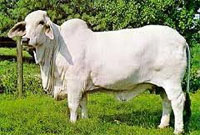 |
|---|
Non-Boston Brahman |
The most common cattle breed here is Brahman (not to be confused with a Boston Brahmin, ayuh). This hearty breed, the same one prevalent in India, is used because it resists heat and insects well. But the beef and the way it's raised and processed here (open grazing, no aging) does not result in tender meat. Often, the cattle here have grown old and tired and then they're sent to the butcher, kinda like what you do with an old pensionado. (I wonder if the cattle in India became sacred because they were too damn tough to eat?)
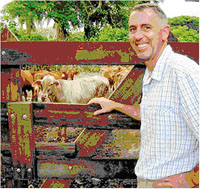 |
|---|
Loray Griener and Some of His "Brangus" Cattle |
But now there has been a glimmer of hope reported in the press. A gentleman named Loray Greiner who lives in La Garita, about 20 miles southwest of San José, has taken it upon himself to develop a first rate beef industry in Costa Rica. Mr. Greiner can build on his father's 30 years of work developing new breeds of cattle and new types of grasses. The younger Greiner is also working on more new breeds such as a cross between a Brahman and an Angus he calls "Brangus" and new feeds that come from a different kind of grass mixed in with legumes, hopefully to give the resulting beef better flavor..
Besides the Brangus, Mr. Griener is also trying to cross angus or Brangus with the famous Japanese Wagyū cattle, whence cometh the famous Kobe beef. I tried a piece of this beef in a Japanese restaurant in Brussels in the '70's (menu price 1975 - 30 dollars for about 10 ounces - fortunately not my tab). It's not hard to describe what the ultimate in beef flavor and tenderness can be like - it's called Kobe.
So go for it Loray, you've got thousands of carnivorous expats here waiting in line for your successful product and when Ticos get a taste of really good beef, you'll have hundreds of thousands more (served with a side of gallo pinto, of course).
¡Pura Vida!
.jpg) |
|---|
Chepito Flashing His Cédula With 10 March, 1900 Birth Date |
In the April 2013 issue we wrote an article about José Delgado Corrales, better known in Costa Rica as "Chepito". Delgado has an interesting cédula (national ID card); it shows he turned 113 this past March 10 and is the oldest person in Costa Rica.
Now comes a report that the oldest man in the world, a Japanese gentleman named Jiroemon Kimura, died June 13 at age 116 (ne 1897), leaving a Japanese woman from Osaka the new oldest person in the world at 115. (Do you think it might be the sushi with the Japanese?)
So Chepito is getting closer to the top. He doesn't credit his longevity to anything in particular but I'm betting it could be the Gallo Pinto. And I'll also bet the Japanese folks didn't celebrate their 113th birthday at the local TGIF emporium like "Chepito" did.
Go for it Chepito!
Rumble Talk
(Shaky Happenings On or About the Pacific Rim)
All is relatively quiet on the Western and other fronts of Costa Rica.
GGC's Technical Research Department (guess who that is) has added a link below to the U.S. Geodetic Survey that produces a report on earthquakes around the world greater that Richter 2.5. The basic data pinpoints the exact coordinates, strength and physical location of all earthquakes occurring in the last 24 hours around the globe. You can look at them as a list or as a distribution on a map.
You can also use their custom option feature to search a particular time range, area of the world or intensity. I tested the system for September 5, 2012 and found the 7.6 monster that hit us on that day. Not only that, the system noted that there were 6 other terremotos in the 4.5 to 4.6 range that day in Costa Rica. Believe me, most of us weren't impressed with the smaller ones that day.
(Three days after the above was written, we were treated to a 4.5 jolt just before 9 PM that lasted only a couple of seconds. The Costa Rica authorities reported the magnitude and location very quickly. The epicenter? "Between Quepos and Manuel Antonio". In other words, under GG's apartment. ...Dude)
Check Out Recent Earthquakes Around the World Posted by the U.S. Geodetic Survey: Today's Quakes |
|---|
Las Carretas de Costa Rica
(My Cart's Prettier than Your Cart)
 |
|---|
Sarchi Rocker |
As I write this I'm sitting in a wooden rocking chair I bought about a year after arriving in Costa Rica.
I bought the chair at a store just a block and a half from my apartment. The name on the door was Sarchi. I thought at the time that it was simply the name of the store owners but later learned it stood for a special type of furniture and that the furniture is named after the town it comes from, Sarchi, Costa Rica. I tested out a rocker and then bought it for $100.
The salesperson delivered it to my apartment by turning it upside down over his head and walking it the block and a half and up one flight of stairs to my abode. We keep things simple here amigos, including furniture delivery.
The rocker looks like the one in the picture to the right except the one I have has brown leather with an embossed design for the seat and back straps. After four years of service, the joints of the rocker have loosened a bit and it squeaks a little when I ensconce my considerable being into it but it continues to perform as well as can be expected.
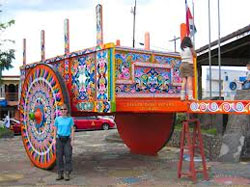 |
|---|
Claimed as World's Largest Oxcart (That's a Six Foot Dude Standing by the Wheel). Does it Need the World's Largest Ox? |
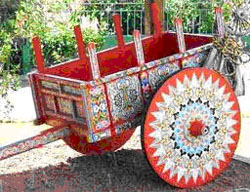 |
Regular Size |
 |
Intricate Design Detail |
Rocking chairs are not the only thing produced in Sarchi, The town is perhaps best known for construction of oxcarts with a wide range of artistic designs on both the body and wheels of the cart. Ticos call them "carretas", which is simple Spanish for cart or wagon.. Sarchi boasts the largest carreta in the world as shown in the picture to the left. I'm not sure why anyone would want to build the largest oxcart in the world unless, perhaps, they owned the largest ox.
Today these carts, at least the decorated ones, are mainly for display of their artistry. They take important positions in parades and celebrations around the country. There is even a parade held once a year on the second sunday in March in San Antonio de Escazú, a hill town near San José, where the oxcarts are the primary feature. The festival is known as the Dia de las Boyeros or Day of the Oxcart Drivers.
Visitors to Sarchi are encouraged to spend some time in the factory stores there. The best known, oldest and largest one is the Joaquín Chaverri Oxcart Factory. It opened in 1902 and has a very large showroom of decorated and undecorated but assembled oxcarts. The employees are quite willing to break them down quickly and make them ready for immediate shipment (credit cards work here amigos).
The oxcart was not always a celebration of artistry. In the early days it was the primary mode of transportation for coffee beans from the farms to the coast. There are records dating back as far as 1820 showing coffee was already an export. The railroad between the Central Valley and Limón, the only major port at the time, wasn't completed until 1890 (see Choo Choo Chiquita).
So oxcarts were employed to haul ripe but unroasted coffee beans to the coast where they would be shipped to various countries for local roasting and distribution. Of course there were no paved roads then so the carts were particularly useful in negotiating the rugged jungle trails that might often be clogged with mud.
Oxcarts, mostly undecorated, are still actively employed in farming here. In an article in the Chronicles two months ago (More on Palms and Pods) it was reported that oxcarts are the preferred method for collection and transportation of palm oil dates by the major producer here (Palma Tica). This company likes the fact that an oxen, a carreta and one man can do the same amount of collection as a cart, tractor and two men. No gas, at more than $5 a gallon currently, or maintenance required. I suspect a lot of independent farmers see it that way also.
So, if you want to see an example of Costa Rican artistry that evolved from commercial need, make a visit to Sarchi. It's about 30 kilometers. or less than 20 miles, as the hummingbird flies, northwest of San José (not sure how far it is as the car drives).
¡Pura Vida!
Don't Pitch the Paw Paw Seeds
(Another Weapon For Fighting Dengue)
Papaya trees are prolific in Costa Rica, you can find them just about anywhere. The papaya fruit also goes by another name, Paw Paw.
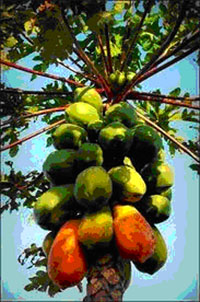 |
|---|
Papaya Tree |
About two years ago my landlady decided it would be a good idea to plant a papaya seedling in a two foot wide strip of land close to their house that serves as a border for the tenants' parking area. "Fresh fruit" said she. It turned out to be not such a good idea amigos, as these trees grow almost as fast as bamboo.
Within a year the sapling had grown into a tree and within two years the leafy top was higher than the roof of their casa and my apartamento, which is on the second floor. All along the way the tree produced sweet, succulent fruit which the apartment folk and host family could share. We all enjoyed picking fresh papaya for a while but eventually the only way to get at the fruit, which is at the top of the tree, was to approach the tree from the roof of the villa.
Eventually the tree had to be cut down and removed as the roots were beginning to undermine the house.
For those who have never tasted it, papaya has soft, slightly sweet flesh that makes a dynamite smoothie all by itself or in combination with other fruit like pineapple, melon, banana etc. It's good by itself, but blending it with other fruits and water or milk produces a delicious and healthy drink by almost anybody's standards..
GG has noted before in the Chronicles that his knowledge of things tropical could stand embellishment. A case in point is that I thought it reasonable, when preparing a papaya, to completely discard the large amount of seeds in the center of the fruit. Wrong once more, oh Golden Guru. Reports are now circulating that there are great health benefits to papaya and that the seeds can help fight dengue fever, maybe even cure it.
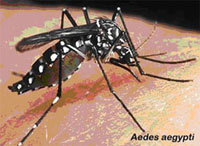 |
|---|
Dengue Skeeter |
Dengue is a nasty disease found in warm climates (including the southern U.S.) and is particularly virulent in tropical zones. It's carried primarily by ugly little spotted mosquitoes like the one shown to the right. The onset of the dengue season corresponds with the beginning of the rainy season. The dengue skeeters, like most mosquitoes thrive in stagnant pools of water.
Symptoms of dengue include fever, headache, muscle and joint pains, and a characteristic skin rash that is similar to measles. Sort of like a flu, dengue can be debilitating and, in some cases, fatal. For more details on the disease and how it's transmitted go here: Dengue.
A couple of weeks ago, as I was leaving my apartment, a Policia Turistica truck was passing by my building, whooping up their siren and announcing over their PA system that spraying the neighborhood for dengue would happen at 5 that afternoon. That was good for me as I was gone from 4 to 9PM and the vapor they use stinks. A few days later pamphlets listing preventive measures against dengue were stuck on our gate.
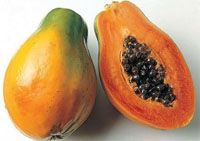 |
|---|
Halved Papaya & Seeds |
So how do papaya and papaya seeds fight dengue? There are many health claims about the benefits of papaya and papaya seeds in the literature, to wit:
- papaya contains the protein digesting enzyme papain which can dissolve the protein coating that forms around cancer cells and helps the immune system to destroy them more easily. It also contains isothiocyanate which directly inhibits cancer cell growth.
- the fruit contains fibrin which reduces the risk of blood clots and helps circulation
- papaya contains numerous antioxidants such as carotenes, lycopenes, (hence the yellowish-orange color of the fruit, similar to carrots), vitamins C, E and A and flavonoids; all of which are good for the cardiovascular system
- the seeds have anti-bacterial properties and are effective against E.coli, Salmonella and Staphylococcus infections. This results in fewer colds and flues.
- papaya seeds can eliminate intestinal parasites and help detoxify the liver. They're also reported to cure piles and, in Nigeria, they are used as a cure for typhoid fever.
- the leaves of papaya, crushed and squeezed for their juice are the strongest for preventing dengue
Now here's the bad news. Papaya seeds and the juice from the leaves are reported to be quite bitter to the taste. When GG heard this, the Chronicles Consumer Research Department (guess who that is) swung into action and purchased a locally grown papaya to sample the seeds for taste. A local merchant at the Feria where I bought the fruit suggested not to break or crush the seeds as the real bitterness is inside the seeds.
So I gently mixed a tablespoon of seeds taken directly from the fruit into a large glass of a smoothie made from papaya, pineapple and milk. I was careful to simply swallow the seeds and not chew or break them, I detected no bitterness offsetting the normal, sweet taste of the fruit but perhaps there was just a little more tartness than a mixture without the seeds would have had. Since then I've taken, once or twice per week, a spoonful of seeds all by themselves when I have them available.
So eating paw paw seeds is another natural remedy to add to the list of healthy practices available from natural ingredients and native lifestyles. Hopefully they will keep dengue away, but in case you are infected, make sure also that you don't hesitate in seeing a physician.
Dengue is not something to be taken lightly.
¡Buen Salud!.
Pass the Grasshoppers Please
(Cooking That Can Bug You)
After reading the article on eating papaya seeds, I suspected one could find a lot worse things to eat. Then I came across an article that made eating paw paw seeds seem like a piece of cake.
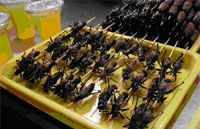 |
|---|
Crickets on a Stick |
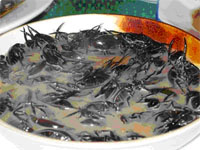 |
Scorpion Beetle Soup |
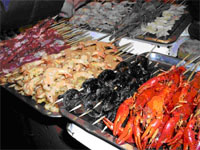 |
|---|
Beijing Snacks - Mice |
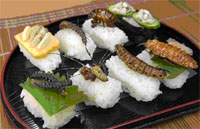 |
Insect Sushi |
A recent news report quoted a study by the U.N. Food and Agriculture Organization that suggests insects could be used to supplement diets around the world and particularly in countries where starvation is a problem. I don't think they're talking about the occasional fly in the soup here amigos.
Eating insects, or even rodents and other small animals, as snacks or meal supplements is not new in the far east, it's been a normal way of living for centuries in places like Thailand and China. There are many insects considered edible, to wit: Worms (Agave, Bamboo, Earth, Horn, Mopane, Silk, Wax), Ants (Carpenter, Leaf-cutter, Honeypot, Lemon, Flying), Bee Larva, Centipedes, Crickets, Roachs, Dragonflies, Dung Beetles (yeah that's right, Dung Beetles), Fly Pupae (yum), Grasshoppers, Grubs, Scorpions, Tarantulas and Termites. Of course, I'm sure I've missed a few others here.
| Cookbooks to Bug You |
|---|
• Creepy Crawly Cuisine: The Gourmet Guide to Edible Insects, by Julieta Ramos Elorduy |
Not only are there a wide variety of insects that are considered edible but there are a surprising number of cookbooks dedicated just to bug cuisine. Three are listed to the right and all three are available on Amazon - so go ahead, try your culinary expertise - just don't invite me to dinner please.
The U. N. article also made mention of the great possibilities of using insects as food in Costa Rica. That's because we have so many varieties of bugs here (see Of Rain and Bugs).
But if I read the Costa Rica culture and psyche right, I'll be surprised if Ticos take up this challenge soon. Perhaps the locals might first try the ones that taste like chicken (I'm not sure which ones they are and I don't want to find out). Chickens and chicken emporiums are prolific here and sometimes I think the chicken should be designated the national bird.
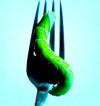 But I believe it will be a long time before the local menus will feature "Arroz con Críquet" (fried rice with crickets) as an option to the chicken version, Arroz con Pollo.
But I believe it will be a long time before the local menus will feature "Arroz con Críquet" (fried rice with crickets) as an option to the chicken version, Arroz con Pollo.
So this is what the greenies really mean by sustainable development, eh.
Hic!
What's-in-a-Word
Entomophagy
Entomophagy (from Greek ντομος éntomos, "insect", and φᾰγεῖν phagein, "to eat") is the consumption of insects as food. Insects are eaten by many animals, but the term is generally used to refer to human consumption of insects; animals that eat insects are known as insectivores. Sorry, but I can't see myself as an entomophagore.
ROMEO Corner
(Retired Old Men/Maidens Eating Out)
Kúkula's
Location: Boca Vieja, over the one lane bridge out of Quepos, about 1/4 mile on the left.
Hours: Lunch and Dinner Tuesday thru Sunday
Parking: Ample on the streets surrounding the restaurant.
Contact: Tel.: 2777-2735; Email: N/A; Website: N/A
Reviewing ROMEOS: Jane K., Janet B., Ann P., Dianne P., Brian M., Bob N.
Note that the ROMEO review group this month includes a majority of women for the first time. The group never intended to and never did exclude women. A friend suggested that the acronym could just as easily stand for Retired Old Maidens Eating Out. So let it be written, so let it be done! - GG
To Review Our Rating System and Procedure, go here: R.O.M.E.O. Rating System
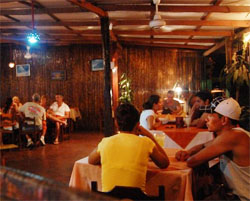 |
|---|
Kúkula at Dinner Time |
This is a true Tico "marisqueria", a restaurant dedicated to seafood, the source of which is practically out their back door. The owner, Ranier, who also happened to be our waiter during the review, has a family member that operates a commercial fishing boat out of Port Quepos. Martec, the biggest fresh fish processor in the area also is only two blocks away, so the restaurant is easily supplied with fresh seafood.
The restaurant decor is folksy and the dining room is heavy with natural woods of Costa Rica. The lighting is pleasantly subdued. The tables are decorated simply giving a warm atmosphere for friends and families to gather- the place is basically for eating, not show. The only thing the group found a little uneasy is that the restaurant is right on the main drag into Quepos and, like many restaurants here, is open to the atmosphere so it can be a bit noisy. The group settled on an atmosphere rating of 3 1/2 sloths,
You can get meat or salads for the main course here but I'm not sure why anyone would do so. The menu is replete with seafood dishes ranging from the ever-popular arroz con camarones (fried rice with shrimp) to whole red snapper to brochettes of seafood and many other combinations and options in between. Our party had all three of the items mentioned above and all ROMEOS pronounced the food delicious, resulting in a food quality rating of five sloths. GG's brochette was a mixture of mahi-mahi and large shrimp, very fresh, very tasty. The brochette was served with the ubiquitous and basic steamed rice (in this case it was Jasmine) and a small cup of black beans. The beans had an interesting flavor not encountered before and which kept us guessing as to the ingredients. |
 |
|---|---|
$$$1/2 |
|
Value Index: 4.0/3.5 = 114 |
As mentioned before the owner, Ranier, served us personally and was very attentive and understanding about things like splitting dishes and the cuentas (checks). The kitchen was a bit slow but nothing out of the ordinary for this area and meals were served pretty much together versus delivering meals separately over an extended period, an irritating penchant among some tico restaurants here. For service we gladly gave the
Kúkula four sloths and the overall rating for food quality, service and atmosphere of 4.0.
The checks were difficult to average because of all the splitting and sharing going on but the menu prices suggest a quite reasonable per plate cost, especially when one considers it is fresh seafood. The shrimp/fish brochette with a diet coke came in around 7,000 colones ($13). This puts the dollar rating in the range of three and a half and the value index equal to 4.0/3.5 or 114, slightly higher than the mid-range of all restaurants in the area.
The Kúkula is a very nice option for dining for anyone, single or family, in the area.
don Beto de Quepos,
El Gringo Dorado Pura Vida! |
Be pithy but kind. I'm sensitive. |
|---|

